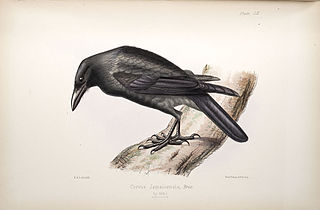
The Jamaican crow is a comparatively small corvid. It shares several key morphological features with two other West Indian species, the Cuban crow and the white-necked crow of Hispaniola, which are very closely related to it.

The purple starling, also known as the purple glossy starling, is a member of the starling family of birds.

The brown-throated wattle-eye, also known as the common wattle-eye or scarlet-spectacled wattle-eye, is a small, insectivorous passerine bird. The wattle-eyes were previously classed as a subfamily of the Old World flycatcher family Muscicapidae, but are now usually separated from that group.
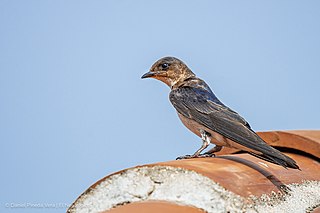
The grey-breasted martin is a large swallow from Central and South America.

The common footman is a moth of the family Erebidae. The species was first described by Johann Leopold Theodor Friedrich Zincken in 1817. It is distributed throughout Europe and east through the Palearctic to Lake Baikal.

The red bird-of-paradise, also called the cendrawasih merah, is a bird-of-paradise in the genus Paradisaea, family Paradisaeidae.

Smerinthus ocellatus, the eyed hawk-moth, is a European moth of the family Sphingidae. The species was first described by Carl Linnaeus in his 1758 10th edition of Systema Naturae.

The black partridge, also known as the black wood partridge, is a small partridge with a thick bill, grey legs and dark brown iris. It is the only member of the monotypic genus Melanoperdix.
The Tasman starling was described in 1836 by John Gould as a species which occurred on both Norfolk Island and Lord Howe Island. In 1928 Australian ornithologist Gregory Mathews recognized that the plumage of the race from Lord Howe Island was much browner and more greyish than the plumage of the Norfolk Island race and split the species into two forms, the Norfolk starling, and the Lord Howe starling. Both subspecies are now extinct, thus so the species.

The Christmas imperial pigeon, also known as Black imperial pigeon, Dusky imperial pigeon, Wharton's imperial pigeon, or burong pergam, is a large imperial pigeon endemic to Christmas Island in the northeastern Indian Ocean. It has an overall grey-blue colouration, and juveniles are duller than adults. It makes a soft purring coo sound and a deeper whoo sound comparable to a cow mooing. It lays one glossy white egg per brood, and is possibly somewhat colonial.

The black arches or nun moth is a small Palaearctic moth. It is considered a forest pest.
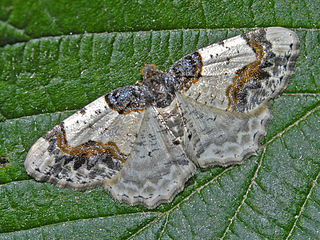
Ligdia adustata, the scorched carpet, is a moth of the family Geometridae.

Caradrina morpheus, the mottled rustic, is a moth of the superfamily Noctuoidea. The species was first described by Johann Siegfried Hufnagel in 1766. It is found across the Palearctic from northern Europe to Siberia, Amur and Korea. Also in Armenia and Turkestan. It was accidentally introduced on both the east and west coasts of Canada and is so far reported in the east from New Brunswick to Ontario, and in the west from British Columbia.

Noctua orbona, the lunar yellow underwing, is a moth of the family Noctuoidea. It is found in the Palearctic.
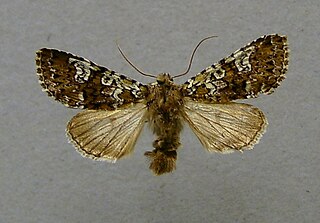
Crypsedra gemmea is a moth of the family Noctuidae. It is found in Central and Northern Europe.
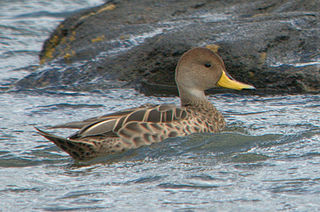
The Chilean pintail, also known as the golden peck duck or brown pintail, is a subspecies of the yellow-billed pintail, a duck in the dabbling duck subfamily Anatinae. Its local names are pato jergón grande, pato maicero and pato piquidorado in Spanish, and marreca-parda or marreca-danada in Portuguese.
The Elizabeth is a breed of domestic duck, originating in Australia. They were developed as a small, fast growing meat breed in 1972 by Lance Ruting in Merrylands, New South Wales and named after his wife, Ann Elizabeth Ruting. They are presently bred in Australia and New Zealand, but are not widely available and classified as endangered by the Rare Breeds Trust of Australia.
Pilocrocis hypoleucalis is a moth in the family Crambidae. It was described by George Hampson in 1912. It is found in Mexico (Tabasco), Panama and Jamaica.
Syllepte molybdopasta is a moth in the family Crambidae. It was described by George Hampson in 1918. It is found in Papua New Guinea, where it has been recorded from Rook Island in the Bismarck Archipelago.
Onebala probolaspis is a moth in the family Gelechiidae. It was described by Edward Meyrick in 1929. It is found in South Africa.














